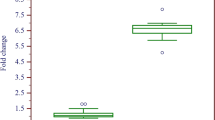Abstract
Daintain, a novel bioactive peptide produced and secreted by macrophages, was expressed in breast tumor tissues. The spatial distributions of daintain in 66 breast tumor specimens were investigated with immuno-histochemistry method. Reverse transcription polymerase chain reaction (RT-PCR) and in situ hybridization inspection system were also used to detect daintain in 45 cases of malignant breast tumors. The final results show that 93% high positive responses to daintain on breast cancer tumors. RT-PCR demonstrated that, no smear of daintain transcripted in benign tissues was found, and light smear in peri-cancer tissue was observed. Distribution of daintain was distinguishable among benign tissues, hyperplasia tissues, immature hyperplasia and invasive breast cancer, which can be used to mark the progression of the malignant lesion development. We conclude that the expression of daintain is up-regulated in breast cancers, which indicates that the peptide is closely associated with the disease progression. So daintain could be used as the biomarker for detecting breast cancer.
Similar content being viewed by others
References
Gradishar W J. The Future of Breast Cancer: The Role of Prognostic Factors [J]. Breast Cancer Res Treat, 2005, 89: S17–26.
Chen Z W, Ahren B, Ostenson C G, et al. Identification, Isolation and Characterization of Daintain (Allograft Inflammatory Factor 1), A Macrophage Polypeptide with Effects on Insulin Secretion and Abundantly Present in the Pancreas of Prediabetic BB Rats [J]. Proc Natl Acad. Sci, 1997, 94(25): 13879–13884.
Utans U, Quist W C, McManus B M, et al. Allograft Inflammatory Factory-1. A Cytokine-Responsive Macrophage Molecule Expressed in Transplanted Human Hearts[J]. Transplantation, 1996, 61(9):1387–1392.
Utans U, Arceci R J, Yamashita Y, et al. Cloning and Characterization of Allograft Inflammatory Factor-1: A Novel Macrophage Factor Identified in Rat Cardiac Allograft with Chronic Rejection[J]. J Clin Invest, 1995, 95(6):2954–2962.
Watano K, Iwabuchi K, Fujii S, et al. Allograft Inflammatory Factor-1 Augments Production of Interleukin-6,-10 and-12 by a Mouse Macrophage Line[J]. Immunology, 2001, 104(3): 307–316.
Neville M J, Campbell R D. A New Member of the Ig Superfamily and a V-ATPase G Subunit Are Among the Predicted Products of Novel Genes Close to the TNF Locus in the Human MHC[J]. The Journal of Immunology, 1999, 162(8): 4745–4754.
Schluesener H J, Seid K, Kretzschmar J, et al. Allograft-Inflammatory Factor-1 in Rat Experimental Autoimmune Encephalomyelitis, Neuritis, and Uveitis: Expression by Activated Macrophages and Microglial Cells[J]. Glia, 1998, 24(2): 244–251.
Autieri M V, Carbone C M. Over Expression of Allograft Inflammatory Factor-1 Promotes Proliferation of Vascular Smooth Muscle Cells by Cell Cycle Deregulation[J]. Arteriosclerosis, Thrombosis, and Vascular Biology, 2001, 21(9): 1421–1426.
Pashenkov M, Efendic S, Zhu J, et al. Augmented Expression of Daintain/Allograft Inflammatory Factor-1 is Associated with Clinical Disease: Dynamics of Daintain/Allograft Inflammatory Factor-1 Expression in Spleen, Peripheral Nerves and Sera During Experimental Autoimmune Neuritis[J]. Scandinavian Journal of Immunology, 2000, 52(2):117–122.
Deininger M H, Seid K, Engel S, et al. Allograft Inflammatory Factor-1 Defines a Distinct Subset of Infiltrating Macrophages/ Microglial Cells in Rat and Human Gliomas[J]. Acta Neuropathol (Berl), 2000, 100(6):673–680.
Ilvan S, Celik V, Cetinaslan I, et al. Immunohistochemical Analysis of Prostate-Specific Antigen in Female Breast Cancer[J]. Balkan Union of Oncology, 2004, 9(2):183–186.
Choudhury M, Singh S. Detection of HPV16 and 18 By in situ Hybridization in Precancerous and Cancerous Lesions of Cervix[J]. Indian J Pathol Microbiol, 2006, 49(3):345–347.
Merly F, Lescaudron L, Rouaud T. Macrophages Enhance Muscle Satellite Cell Proliferation and Delay Their Differentiation[ J]. Muscle Nerve, 1999, 22(6):724–732.
Kuschel R, Deininger M H, Meyermann R, et al. Allograft Inflammatory Factor-1 is Expressed by Macrophages in Injured Skeletal Muscle and Abrogates Proliferation and Differentiation of Satellite Cells[J]. J Neuropathol Exp Neurol, 2000, 59(4):323–328.
Tian Y, Autieri M V. Cytokine Expression and AIF-1-Mediated Activation of Rac2 in Vascular Smooth Muscle Cells: A Role for Rac2 in VSMC Activation[J]. Am J Physiol Cell Physiol, 2007, 292(2): 841–849.
Autieri M V, Kelemen S E, Wendt K W. AIF-1 Is an Actin-Polymerizing and Rac1-Activating Protein That Promotes Vascular Smooth Muscle Cell Migration[J]. Circulation Research, 2003, 92(10): 1107–1114.
Author information
Authors and Affiliations
Corresponding author
Additional information
Foundation item: Supported by the National Natural Science Foundation of China (30370647, 30470823)
Biography: LI Fafang(1970–), female, Ph.D. candidate, Lecturer for Youjiang Medical College of Nationalities, research direction: medical biochemistry of protein.
Rights and permissions
About this article
Cite this article
Li, F., Xia, H. & Chen, Z. Polypeptide daintain as a new biomarker for detecting breast tumor. Wuhan Univ. J. Nat. Sci. 13, 118–122 (2008). https://doi.org/10.1007/s11859-008-0123-3
Received:
Published:
Issue Date:
DOI: https://doi.org/10.1007/s11859-008-0123-3
Key words
- daintain
- breast cancer
- immuno-histochemistry
- reverse transcription polymerase chain reaction(RT-PCR)
- in situ hybridization




